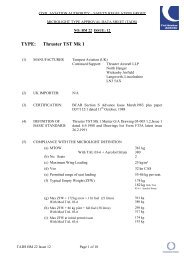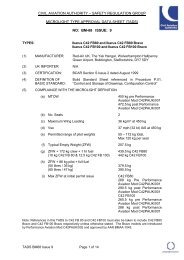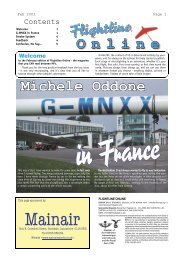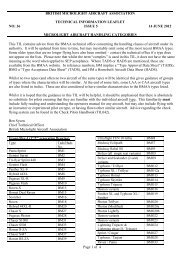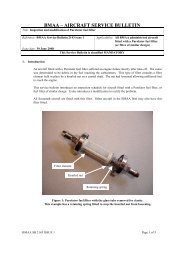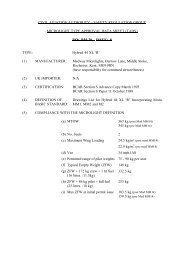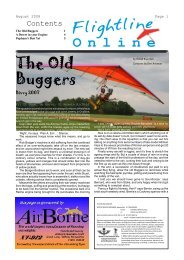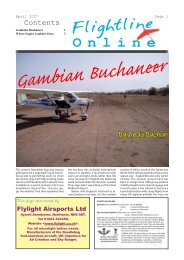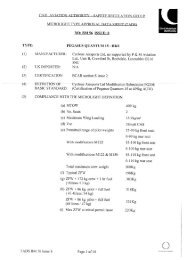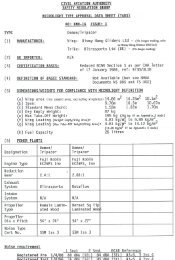French Kiss - British Microlight Aircraft Association
French Kiss - British Microlight Aircraft Association
French Kiss - British Microlight Aircraft Association
Create successful ePaper yourself
Turn your PDF publications into a flip-book with our unique Google optimized e-Paper software.
23 top surface and 12 undersurface batons maintain the wing profile. The batons are retained<br />
in their pockets by ordinary cord rather than the ubiquitous bungee. According to Dewhurst,<br />
the dimensional stability of the sail material obviates the need for a flexible baton retention<br />
system. Certainly the machine flies straight as a die in the air. Should a turn ever manifest<br />
itself, it can be tuned out by rotation of the sail attachments at the wing tips.<br />
Structurally speaking, the wing holds no surprises. Interest is once more in the detail. For<br />
instance you won't find a bolt through a bit of ali channel hinging the crosstubes to the leading<br />
edges. This <strong>French</strong> machine uses a purpose designed complex hinge giving a controlled<br />
movement in three axes. The hinge components are individually machined from solid metal.<br />
Having said this, I rather like the simplicity of a simple aircraft quality bolt at this lifedetermining<br />
position.<br />
The trim system shows the same attention to quality and detail. The trim knob on the A-frame<br />
uses integral gearing to ease use in the air while wearing thick gloves. The system acts on<br />
the middle luff lines only but this is sufficient to take 10mph off the 60mph untrimmed<br />
airspeed.<br />
The airframe uprights have been faired with clip-on profiled coverings offering a neat,<br />
structurally neutral solution to draggy tubes. Some enterprising chap should offer them for<br />
sale to those of us with older trikes: I am sure that there would be quite a few buyers for such<br />
a simple solution to an old problem.<br />
In Flight<br />
With Paul Dewhurst shoe-horned into the back seat we commenced taxiing to the easterly<br />
holding point at Sywell. The massive foot-shaped pedals for brake and throttle are also the<br />
footrests and operating them smoothly does take a bit of practice. Ground steering is<br />
satisfactory - very little wallowing on the suspension - although the drum brake on the front<br />
wheel is not progressive and tends to snatch.<br />
Lined up and cleared by the Tower, the excitement begins. The first thing you notice on<br />
opening the throttle fully is how leisurely the 582 sounds. Although it pulls 6200rpm, the big<br />
reduction on the slow-turning prop made me wonder if I had opened the throttle fully. The<br />
next 100 metres of travel down the slightly bumpy grass strip dispels any doubt with the<br />
machine rotating decisively at just over 40mph IAS.<br />
You know instantly that the machine is a good one. It leaps into the air in an absolutely<br />
straight line and the pilot becomes immediately aware of the positive forward bar pressure<br />
required to keep airspeed down to 50mph for best climb performance.<br />
And what performance! The <strong>Kiss</strong> had no trouble sustaining a timed 700fpm at the maximum<br />
legal takeoff weight of 400kg. Indeed, it mostly pushed 800fpm fully laden. And it wasn't the<br />
sort climb rate that required a bit of nudging and scratching around the heavens together with<br />
a scrupulous eye on airspeed to maintain. The machine achieved this climb effortlessly and<br />
repeatably.<br />
I couldn't wait to get the thing back on the ground to boot Paul out and see what a <strong>French</strong><br />
<strong>Kiss</strong> could really do. Also, I found that his long legs were projecting so far forward past my<br />
shoulders that I couldn't really pull the bar in far enough for fun without giving him a kneecap<br />
job.<br />
Before this, there were other things which this machine absolutely begged you to try. Blade<br />
and Q(uantum) pilots would be totally familiar with the fully laden pitch response of the <strong>Kiss</strong> -<br />
reassuringly positive and disappointingly heavy. It needs real muscle either to hold the bar<br />
into your chest or outwards against the front strut. Heaving the bar in returned a sustained<br />
IAS of 85mph while straining to keep the bar against the front strut brought the indicated<br />
airspeed down to 40mph without any sign of an imminent stall - both figures obtained at<br />
400kg flying weight.<br />
The engine seemed fairly leisurely in the cruise. With the trim control set at fast giving a handoff<br />
indicated airspeed of 60mph, the rev counter showed 5000rpm. I would guess - and it is<br />
only a guess - that the power setting would equate to about 12-14 litres/hour. Winding up the<br />
trim control took about 10mph off the airspeed but I can't imagine why anyone would really<br />
want to do this in a machine built for going places.<br />
Opening the throttle on most machines while straight and level normally produces a climb<br />
with little change in indicated airspeed. The <strong>Kiss</strong> is unusual. Opening up the throttle puts<br />
about 10mph on the airspeed and requires a pilot input to convert all the added power into<br />
climb. This isn't a problem, just a noticeable difference.<br />
The roll response is probably the lightest that I have ever come across in a two seater flown<br />
two-up. It acts both rapidly and positively and probably requires about half the effort required




